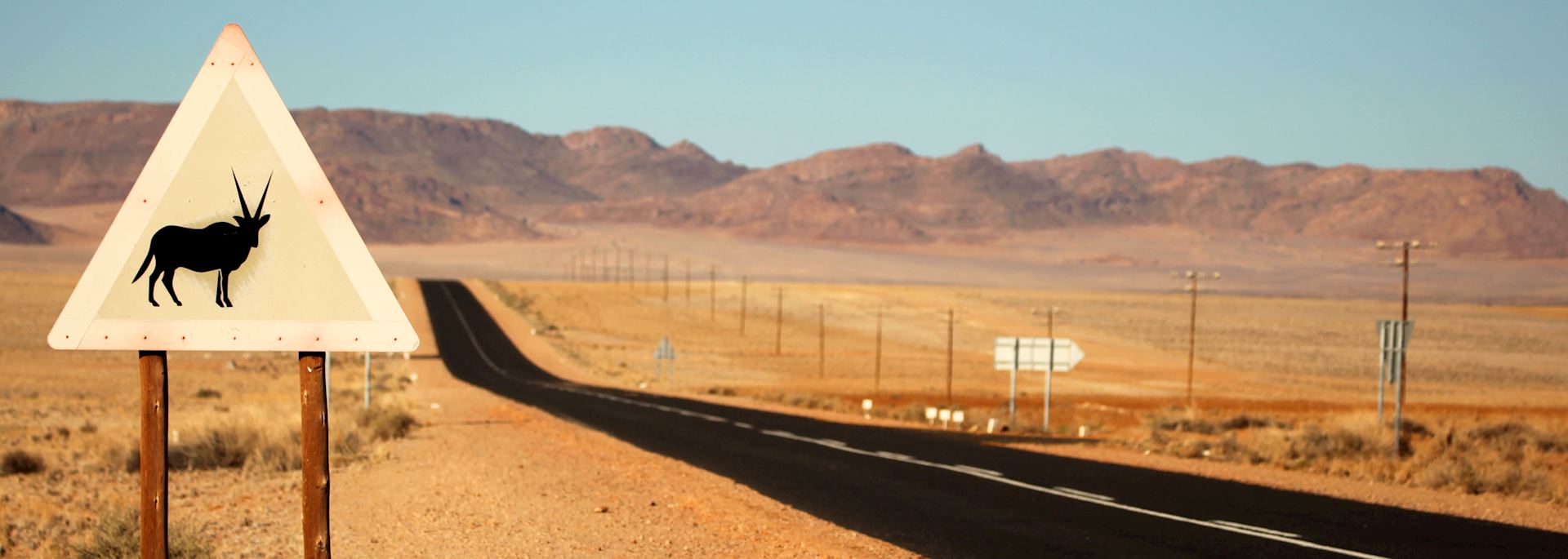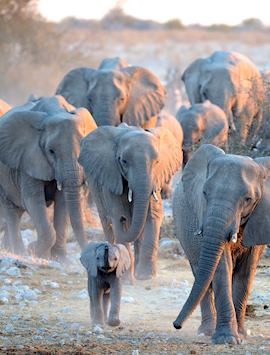By Audley Namibia specialist Kelly
The joy of driving here in Namibia is heightened by the lonely desert roads and grand, sweeping landscapes. Added to that, the high concentrations of game confirm Namibia's position as one of the continent's premier wildlife destinations. Good infrastructure and safe driving conditions make Namibia one of the few places in Africa where self-driving is a viable option and thanks to the dramatic scenery, rare wildlife such as desert-adapted elephant and unique desert experiences, it's a road trip to relish.

Starting your drive at Windhoek
Most self-drive tours of Namibia begin in Windhoek and I'd recommend spending a night here to recover from your flight. For first time visitors, I’d suggest a classic self-drive route, which is a loop southwest of Windhoek, covering about 340 kilometers (210 miles) of wild and rugged desert terrain.

Explore Sossusvlei's towering dunes and desert valleys
Your first destination is the Namib-Naukluft National Park, set in the oldest desert in the world. A vast expanse of shifting sands, it’s reached by a four- to six-hour drive through jagged mountains and desert plains. I took my time and simply soaked up the grandeur of it all.
Most visitors stay in the Sesriem area and it's a good idea to plan two nights here. On your first afternoon take a drive with a local guide who’ll bring the desert to life, explaining the history and formation of the land as well as telling you about plant life, endemic tree species and the culture of the local people. You may also spot oryx, kudu, springbok and mountain zebra, as well as the occasional desert-adapted giraffe.
Set off early the next morning to visit the region's dune fields. With the sun rising as you weave between the towering piles of red sand, the light and shade play across the dunes creating graceful undulating patterns.
Dune 45, an 170-meter-high star-shaped dune, is one of the most accessible in the park and relatively easy to climb, offering expansive views of the surrounding dunes and plains from the summit.
Further on is Sossusvlei, a desert oasis fed by an ephemeral river, and the more impressive Deadvlei, a stark white expanse of salt set among the orange dunes. The glaring white salt pan is pitted with 700-year-old petrified acacia trees and dominated by the Big Daddy dune, the largest in the field at 350 meters high. If you're relatively fit you can climb to the top to look across the whole dune field.
The lodges in the Sesriem area are really beautiful, classically built properties with just 6 to 12 rooms. There are lots of good places to stay, but I recommend either Hoodia Lodge, which is further from the dunes but offers a very intimate experience, or the Kulala Desert Lodge, which is a great wilderness option where you can sleep on the roof under the night skies.

Discover the coastal town of Swakopmund
Swakopmund, a picturesque colonial town sandwiched between the dunes and the Atlantic coast, is a four- to six-hour drive from Sesriem. My favorite stop en route is the little hamlet of Solitaire for some delicious apple pie and good coffee at its amazing German-style bakery.
The closer you get to Swakopmund the more barren and arid the region becomes. The flora and fauna are sparser and the landscape takes on a lunar-like quality. Added to this, an enormous bank of cloud hovers over the town where the cold Atlantic air meets the warmth of the desert, making for an atmospheric final leg to your drive.
Swakopmund itself is a lovely place and has lots of good guesthouses, which I think are best booked on a bed and breakfast rate as the town has so many commendable restaurants. I'd recommend staying at the Cornerstone Guesthouse which offers very comfortable accommodation, including self-catering apartments, and has very helpful staff.
Swakopmund is also Namibia's adventure capital and you can arrange sand boarding and quad biking here. My preference, though, is to take a living desert tour, which highlights all the hidden desert life from cartwheeling spiders to snout-nosed lizards.
You can also take a half-day kayak trip to Pelican Point's seal colony. The seals here are very playful and on my last trip I watched about 30 follow me as I paddled backwards through the water.

Spot desert-adapted elephant and black rhino in Damaraland
From Swakopmund drive to Damaraland, a semi-arid region of prehistoric river valleys, ancient volcanic peaks and massive granite escarpments which contrast starkly with open plains and deep gorges. One of the most interesting places to visit is the Organ Pipes, a series of dolerite pillars exposed by erosion.
At Twyfelfontein you can visit the continent's largest rock art gallery, thought to be 2,000 to 2,500 years old. Created by the traditional bushmen of Southern Africa, there are hundreds of engravings (mostly depicting animals) to discover.
I'd recommend spending two to three nights in Damaraland, splitting your time between the north and south. In the central and northern parts, you'll come across permanent herds of desert-adapted elephant while in the far north you'll find desert-adapted rhino and can visit the Himba people, a semi-nomadic tribe who still live a very traditional life. During your time with them, you may see the villagers milking goats, cooking, covering the women’s hair in red earth or making jewelry.
One of my favorite places to stay is Camp Kipwe, which is built right into the granite rocks. Damaraland Camp is another good bet, but very different with extremely elegant and luxurious safari tents and sweeping views.

Gather around a waterhole in Etosha National Park
It's a three- to six-hour drive northeast to Etosha National Park, one of Africa's greatest wildlife destinations. The park is home to the world's largest population of black rhino and in total is host to 114 different species from elephant, lion and giraffe to cheetah and wildebeest, as well as 340 bird species.
The park is very dry so wildlife congregates around the waterholes making sightings almost guaranteed. Okaukuejo Rest Camp has a waterhole which can only be visited by guests of the lodge and is floodlit at night. The waterhole is a rhino hub and I've sat there watching 14 black rhino drinking together along with herds of elephant and lion.
Although the rooms at the lodge are very spacious and beautifully styled, it's a busy place with over 100 rooms, so service is less personal. However, it’s a small compromise to make in return for the incredible wildlife viewing opportunities here.

See rehabilitated leopard in the Central Highlands
Leaving Etosha, head south, passing through a couple of bustling towns to enter the Central Highlands region. Here you’ll find Okonjima Nature Reserve, home of the AfriCat Foundation. The foundation works to conserve Namibia’s carnivores through research, education, rehabilitation and habitat restoration.
Staying on the reserve, you can head out on game drives to track a number of rehabilitated and wild leopard. Some have been fitted with unobtrusive collars that help guides to identify their location and monitor their movements. Your guide will tell you more about leopard conservation and the educational efforts being made to ensure the survival of the species.
Other conservation efforts that take place at Okonjima include research into animals displaced by farming methods, including rare brown hyena and endangered pangolins.
You can then head back to Windhoek to complete your self-drive loop
Practicalities for self-driving in Namibia
Namibia is a sparsely populated country with broad, flat and largely empty roads making it an ideal destination for self-driving. The day after you arrive a top of the range 4x4 vehicle will be delivered to your hotel along with two spare tires, a cool box and a pre-programmed mobile phone.
Before you set off you'll be given a clear run down on how your vehicle works as well as detailed driving directions. Although only about 25% of this route is tarred, the rest is well maintained gravel and the only problem visitors generally encounter is a flat tire.
For your peace of mind you'll be covered by the highest level of insurance for your vehicle, and you will have the backup of an emergency evacuation service, which will rescue you by whatever means necessary in the event of an incident.
Start planning your self-driving safari vacation to Namibia
Start thinking about your experience. These itineraries are simply suggestions for how you could enjoy some of the same experiences as our specialists. They're just for inspiration, because your trip will be created around your particular tastes.
View All Tours in Namibia




